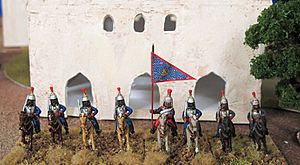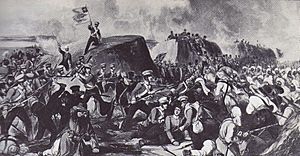François Henri Mouton facts for kids
Quick facts for kids
François Henri Mouton
|
|
|---|---|
| Born | 17 August 1804 Montélimar, France |
| Died | 9 November 1876 (aged 72) Algiers, French Algeria |
| Allegiance | |
| Service/ |
|
| Years of service |
|
| Rank |
|
| Battles/wars |
|
| Awards |
|
François Henri Mouton (born August 17, 1804 – died November 9, 1876) was a brave French Army officer. He started his career in the French army. Later, he became a military advisor for the Sikh Empire in India.
Mouton joined the Sikh army through a friend, Jean-Baptiste Ventura. He led a special cavalry unit called cuirassiers. He fought in battles in the Guler and Mandi hills. He even survived an attempt to kidnap him!
After some time, Mouton returned to France. But he went back to India in 1844. He became a military advisor to the Sikh commander, Tej Singh. He was the only European advisor who stayed with the Sikh army during the First Anglo-Sikh War. He helped plan their defenses in big battles like Ferozeshah and Sobraon. After the war, the British captured him and sent him back to France.
Back in France, Mouton rejoined the French Army. He fought in the Crimean War and earned important awards. He retired as a colonel in 1865.
Contents
Early Life and Joining the Army
François Henri Mouton was born in Montélimar, France. This was on August 17, 1804. He joined the French Army in 1822 when he was 18. In 1826, he became a second lieutenant. He served in the Garde du Corps, who were bodyguards for King Charles X.
He was promoted to lieutenant in 1830. He joined the Spahis, a group of light cavalry from Africa. By 1835, he became a captain. In 1838, there were no jobs for him in the army. So, he was put on "half-pay." This meant he got less money.
Around this time, a French adventurer named Jean-Baptiste Ventura was visiting France. Ventura worked for the Sikh Maharaja Ranjit Singh in India. Mouton asked Ventura to help him find a job with the Sikh Army. Ventura agreed to help him.
Adventures with the Sikh Army
When Mouton arrived in a region called the Punjab, the Sikh cavalry was being reorganized. This was a great chance for him to get a job. He was put in charge of the Sikh cuirassiers. These were soldiers who wore heavy armor. He earned a good salary of 800 rupees a month.
Mouton likely got married around this time. His wife was probably a Muslim woman from Kashmir. In 1839, Mouton and his soldiers were sent to Lahore. Lahore was the capital city of the Sikhs.
Soon after, he went to fight in the Guler and Mandi hills. He fought under Ventura's command. The land was very steep, so Mouton and his cavalry probably fought on foot. In February 1841, some unhappy Sikh soldiers killed another European officer. These rebels then tried to capture Mouton.
Some of Mouton's own soldiers joined the rebels. But others defended him. Mouton's wife bravely begged his soldiers to protect him. They listened to her and drove the attackers away. His wife then convinced the cuirassiers to take them safely to Lahore. The soldiers who helped were given a bonus. They were later moved to Peshawar because people still worried about their loyalty.
The Sikh ruler, Maharaja Sher Singh, was killed soon after this. All the European officers working for him either quit or took a break.
Return to India and the Anglo-Sikh War
Mouton went back to France in 1844. He married Louise Brigitte Jolly there. Later that year, he returned to India. He brought two other officers with him who wanted to work for the Sikh army.
When they reached Ferozepur, they were not allowed to enter the Punjab region. His two friends went back to France. But Mouton went to Bahawalpur instead. From there, he managed to reach Lahore. He couldn't find a job right away. But in September 1845, the Sikh commander, Tej Singh, hired him as a military advisor.
The First Anglo-Sikh War started soon after this. Mouton was the only European officer who stayed with the Sikh army during the entire war. He worked with a Spanish engineer named Hurbon. They planned the defensive trenches used by the Sikhs. These were built during the Battle of Ferozeshah. The British general, Hugh Gough, said the trenches were "well constructed." He noticed his cannons had little effect on them.
Mouton told Tej Singh to attack the British before the Battle of Sobraon. He wanted them to attack while the British were waiting for more soldiers. But Tej Singh did not listen. Mouton helped plan and build the defenses for the Battle of Sobraon. He supposedly told Tej Singh that these defenses could not be broken. During this battle, the last of the war, the British won. They had 1,100 soldiers hurt or killed. Mouton escaped to Lahore. But the British captured him there. They sent him back to France in 1846.
Later Life and Retirement
In 1846, Mouton arrived in Paris. He quickly published a report about his time in India. In this report, he said he was the commander of the Sikh cavalry. He rejoined the French Army. The army usually valued officers who served with the Sikhs.
He became a captain in the 1st Regiment of the Chasseurs d'Afrique. On October 18, 1848, he was made a chevalier of the Legion of Honour. This is a very important French award. Mouton served as a staff officer during the Crimean War (1853–56). For his service, the Ottoman Empire gave him the Order of the Medjidie, 4th class. This was on October 5, 1855.
He was promoted to officer in the Legion of Honour on November 15, 1856. By this time, he was a "chef d'escadron" in his regiment. Mouton reached the rank of colonel before he retired in 1865. He passed away in Algiers on November 9, 1876. Mouton had a collection of Sikh art. This collection is now part of the Toor Collection.



